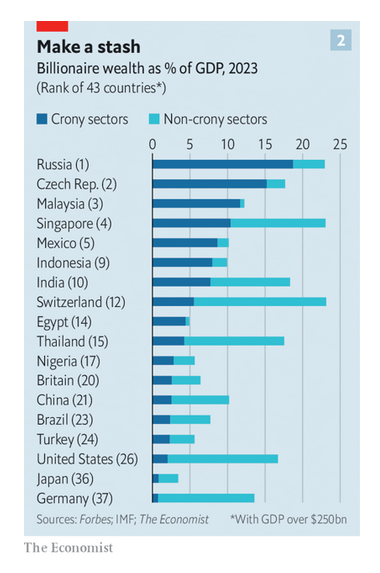
KUALA LUMPUR (May 3): Malaysia has been ranked third behind Russia and the Czech Republic in the latest instalment of The Economist magazine’s crony-capitalism index, which first estimated how much plutocrats profit from rent-seeking industries almost a decade ago.
In the latest edition published on Tuesday (May 2), The Economist said crony capitalists’ wealth had risen from US$315 billion, or 1% of global gross domestic product (GDP), 25 years ago to US$3 trillion (RM13.37 trillion) or nearly 3% of global GDP now.
It said some 65% of the increase came from America, China, India and Russia.
Overall, 40% of crony-capitalist wealth was derived from autocratic countries, and amounted to 9% of their GDP.
The magazine said there are some 311 billionaires around the world whose riches are largely believed to be derived from sectors which often feature chummy dealings with the state.
The Economist said that to calculate all this, it started with data from Forbes.
It said the magazine had published an annual stocktake of the world’s wealthy for nearly four decades.
“In 1998, it estimated that there were 209 billionaires with a total worth of US$1 trillion, equivalent to 3% of global GDP.
“This year, the publication detailed 2,640 billionaires worth US$12 trillion or 12% of GDP. Adjusting for rising prices — US$1 billion in 1998 is now equivalent to US$3.3 billion — there are 877 billionaires (at 1998 prices) with collective worth of US$9 trillion."
The Economist has classified the sources of each billionaire’s listed wealth into rent-seeking and non-rent-seeking sectors.
It explained that an economic rent is the surplus remaining once capital and labour have been paid which, with perfect competition, tends towards zero.
The Economist said rent-seeking is common in sectors close to the state, including banking, construction, property and natural resources.
It said rent-seekers can inflate their earnings by gaining favourable access to land, licences and resources.
They may form cartels to limit competition or lobby the government for cosy regulations. They bend rules, but do not typically break them.
Russia is, once again, the most crony-capitalist country in the index.
Billionaire wealth from crony sectors amounted to 19% of its GDP.
The consequences of the war in Ukraine are clear, however.
Russian crony wealth declined from US$456 billion in 2021 to US$387 billion this year.
Only one-fifth of Russian billionaires’ wealth was derived from non-crony sectors, which showed just how distorted the economy was.
Meanwhile, Chinese billionaires continued to struggle with the vagaries of their government.
The Economist said since Chinese President Xi Jinping launched a crackdown on private capital, crony wealth had fallen sharply, from a peak of 4.4% of GDP in 2018 to 2.5% now.
It said tycoons of all stripes operate only with the consent of the state.
The magazine said that in 1998, there were just eight billionaires in the republic (including Hong Kong and Macau) with total worth of US$50 billion.
Now, there are 562 billionaires commanding US$2 trillion, it said.

